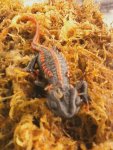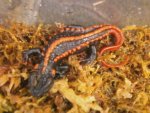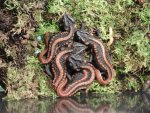MeAndJosephine
New member
- Joined
- Aug 21, 2011
- Messages
- 4
- Reaction score
- 0
- Points
- 0
- Country
- United States
Okay, I have to admit, I did something impulsive today and bought my first amphibian, ever.
I used to manage the reptile department of a pet store, and we always kept firebelly toads, and some turtles in the store, but aside from the newts in the pond out back that I played with when I was a child, I've never even seen one face to face before. I went to the National Reptile Breeders Expo in Daytona Beach, Florida this weekend, and this morning I fell in love with a crazy little salamander. Actually, I guess she's really not even little.
I've been on here ever since I got home with her just trying to figure out what she even was. The guy who sold her to me told me he wasn't even sure what she was. He sexed her for me, and said he knew she was a female and a salamander of some sort, but couldn't even remember where he got her? I didn't like the sound of it, and she was being kept in one of those tiny tupperware bowls they use to transport arachnids and baby snakes and such. She barely even fit, and he offered to let me take her for $10, saying he didn't want to take her home not really knowing what she was, so I took her.
I had NO IDEA what she needed, other than a home, and he told me all she would need was a small critter keeper with some moss in it. Clearly, I was skeptical, but I got a large, sort of shallow critter keeper that's as much ventilation as solid plastic, a bag of moss, a generic fake rock hide house, and a water dish. As soon as I got her in there, she became active and curious, even coming right to my hand.
I've found answers here to most of the things I needed to know immediately, namely what i think she most likely is. She most resembles the pictures I've seen of T. kweichowensis, so I assume that's what she is. I'm attaching a picture, so if I'm wrong on that, please let me know.
One weird thing about her though, her front right foot has at least seven, likely eight separate toes. I haven't noticed anything about this on here, so I was just wondering if anyone thought I need to worry about this little oddity?
I used to manage the reptile department of a pet store, and we always kept firebelly toads, and some turtles in the store, but aside from the newts in the pond out back that I played with when I was a child, I've never even seen one face to face before. I went to the National Reptile Breeders Expo in Daytona Beach, Florida this weekend, and this morning I fell in love with a crazy little salamander. Actually, I guess she's really not even little.
I've been on here ever since I got home with her just trying to figure out what she even was. The guy who sold her to me told me he wasn't even sure what she was. He sexed her for me, and said he knew she was a female and a salamander of some sort, but couldn't even remember where he got her? I didn't like the sound of it, and she was being kept in one of those tiny tupperware bowls they use to transport arachnids and baby snakes and such. She barely even fit, and he offered to let me take her for $10, saying he didn't want to take her home not really knowing what she was, so I took her.
I had NO IDEA what she needed, other than a home, and he told me all she would need was a small critter keeper with some moss in it. Clearly, I was skeptical, but I got a large, sort of shallow critter keeper that's as much ventilation as solid plastic, a bag of moss, a generic fake rock hide house, and a water dish. As soon as I got her in there, she became active and curious, even coming right to my hand.
I've found answers here to most of the things I needed to know immediately, namely what i think she most likely is. She most resembles the pictures I've seen of T. kweichowensis, so I assume that's what she is. I'm attaching a picture, so if I'm wrong on that, please let me know.
One weird thing about her though, her front right foot has at least seven, likely eight separate toes. I haven't noticed anything about this on here, so I was just wondering if anyone thought I need to worry about this little oddity?



